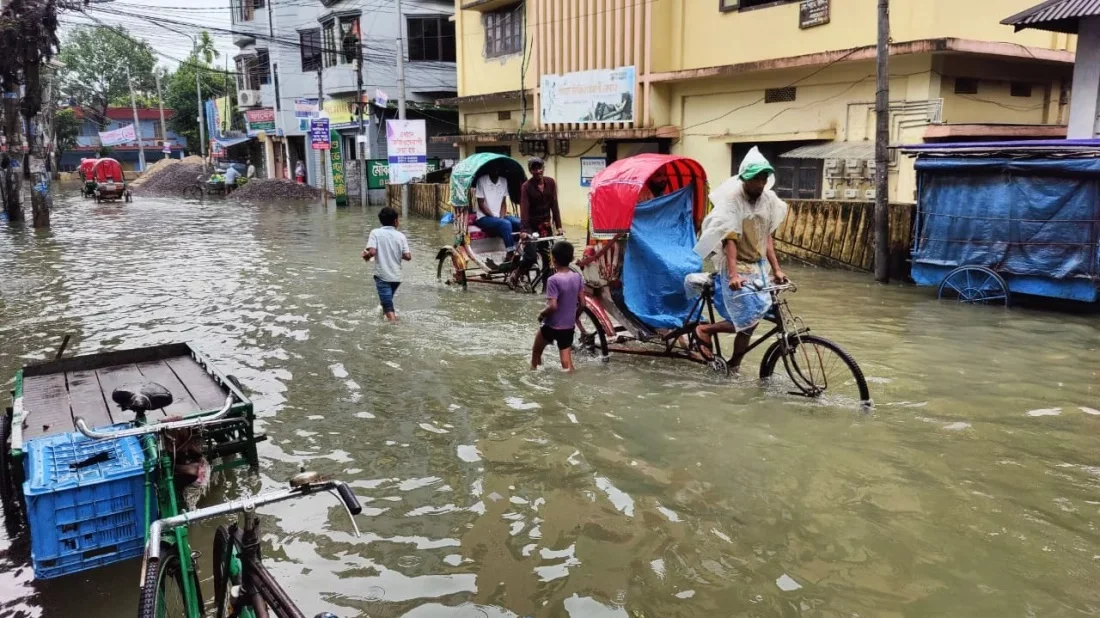Flash flood: 10,000 families marooned in Sylhet city
Share on:

MAG Osmani Hospital submerged, affecting healthcare
The flash flood triggered by the onrush of water from upstream and torrential rain, has left 10,000 families stranded in Sylhet city.
Millions of people are marooned in flood water in Sylhet city.
Out of 42 wards of the city, 28 have been inundated.
From Monday morning, dry food and clean water are being delivered to the flood victims through local councilors under Sylhet City Corporation (SCC).
As the water of the Surma River is flowing over the danger level, the city's canals are now under water. Due to this, flood situations have arisen in the low-lying areas.
Several shelters have already been opened in the city for the shelter of flood-affected people.
Besides, some councillors provide shelter to water-logged people in their respective houses.
Sajlu Laskar, public relation officer of SCC, said that the information obtained from councilors showed that most of the areas of Sylhet city are flood-affected. Sylhet City Corporation is closely monitoring the overall situation. SCC officials will perform roster duty till further orders to deal with flood situations.
The emergency service control room contact phone number (01958-284800) will be open 24 hours.
Meanwhile, Sylhet City Corporation Acting Mayor Md Mukhleshur Rahman Kamran along with other officials visited the flood situation and shelter centres.
They visited different areas of Mirabazar, Terrartan, Uposhahar, and Ward No 10 of the city at 2pm on Monday.
Meanwhile, they talked to the flood-affected people.
Due to torrential rain for several hours on Sunday night and the overflowing of the Surma River, water has flooded new areas of Sylhet city.
Assistant Meteorologist Shah Sajib Hossain of Sylhet Meteorological Office said 226.6mm rainfall was recorded from 6am on Sunday to 6am on Monday. Another 28mm of rain was recorded between 6 am and 9 am on Monday. Besides, 19.2mm rainfall was recorded from 9am to 12pm and 1mm rainfall from 12pm to 3pm. Since then the rainfall has eased.
About 90% of Sylhet city, including Sylhet MAG Osmani Medical College Hospital (SOMCH), the largest hospital in Sylhet, experienced waterlogging.
Ground floors of various buildings of the hospital were flooded with rain water which has disrupted medical services.
According to the Bangladesh Water Development Board (BWDB), the water of the Surma River is flowing 13 cm above the danger level at Sylhet point at 3pm, 60 cm above the danger level at Kanaighat and 42 cm above the danger level at Kushiara.
Brigadier General Dr Mahbubur Rahman Bhuiyan, director of Osmani Medical College Hospital, told reporters on Monday morning that the main gate and the adjoining areas of the hospital have been flooded due to torrential rain. Almost every room on the ground floor of the hospital building has been flooded which triggered suffering to the doctors, patients and officials who came to the hospital on Monday.
When asked why Osmani Medical had been flooded, he said that water had entered the entire ground floor of the hospital and medical college. Last year, when water entered during the flood, the concerned people were repeatedly informed about this, but no action was taken. The waterlogging situation has arisen again this year due to heavy rainfall.
According to medical sources, various buildings and business establishments have been built around the flowing stream near the north side of Osmani Medical College. Due to this, the flow of water has been obstructed.
Many residents of the city have connected the flow of water of drains to Osmani Medical's only drain.
As a result, the rainwater overflowing the drain entered the electric substation of Osmani Medical College Hospital.
Relatives of the patient said that wards no 26, 27 and 31 went under knee-deep water.
Many goods are feared to be damaged due to water entering various rooms.
Those receiving treatment on the ground floor were hurriedly accommodated to two patients in one bed.
The patient's relatives are now fearing contracting various diseases due to entering the water from overflowing drains.

